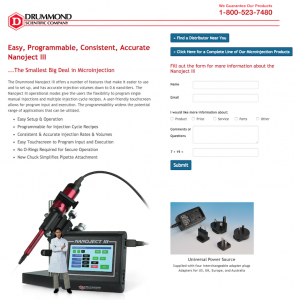By now, most marketers are familiar with the concept of landing pages and what they do. But being familiar doesn’t necessarily equate to having an effective understanding of why designing them correctly is vitally important to your Pay-Per-Click (PPC) campaigns, and any other marketing initiatives a company may be running to drive traffic to them.

Most everyone understands that a good looking design with relevent imagery and well-written, engaging copy means good marketing. The problem is that too many people stop there. Just because an ad or landing page is beautiful, sexy and/or clever doesn’t mean it will convert to contacts and sales. There are key steps to designing an effective landing page that will not only engage the visitor, but more importantly, convert them.
So what are the most important elements? At SMS, we believe that every good landing page must satisfy three basic demands:
1 – The landing page must match the ad or campaign seamlessly. In other words, don’t just sprinkle popular keywords into your campaign or run an ad in front of as many eyes as possible in order to snare the widest possible audience. If a user clicks your online ad or enters your print ad’s listed URL and they’re taken to a landing page that strays even slightly from its core message, they’ll “check out”. Not only that, they are likely to recall a negative experience with your brand which will affect future interactions. It’s also a fact of human nature that negative experiences are more likely to be shared. Not good. Be specific in your campaigns, as the adverse is also true: a user who gets exactly what they’re looking for will keep their eyes open for your brand in the future.
2 – The landing page must have call to action “buttons” spread throughout the page that are easy to find. Laboring over accurate and compelling copy is worthwhile, but most users will skim looking for a way to get the exact info they’re looking for once they feel they’re at the right place. The harder you make that to do, or the longer it takes for them to find a way to click on their needs, the more conversions you’re likely to lose. Shoppers like to reach out and grab what they want when they make up their minds. Be their helping hands.
3 – The landing page must have a separate and trackable URL that demonstrates the brand or ad campaign. For a company selling through PPC ads, this is less important because marketing pros can more easily trace where their traffic originated and how the ad is performing. But for those companies still maintaining an offline presence with tools like print ads and billboards, a more distinct path marker is required to differentiate between direct and organic traffic and traffic generated by a landing page-driven initiative. An accurate account of traffic is important for apportioning marketing budgets so that good money isn’t left floundering in the marketplace due to misjudged efforts.
Remember that marketing is a dynamic science that requires real-time alterations and reevaluations. There are very few hard-fast rules, and even the ones set here will require testing. The best one can do is to continue to monitor customer behavior and direct their marketing efforts as specifically to it as possible.
– S. Norton
For more info on how you can affordably produce your company’s landing pages and run an effective PPC or ad campaign, feel free to contact us for a free, no-obligation consultation.
